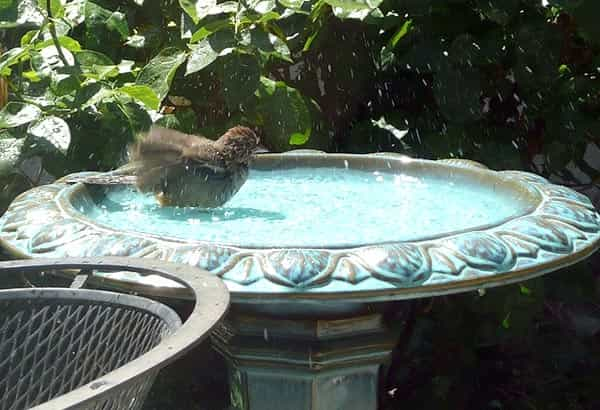What is it for
In gardens, especially those in the most urbanized areas, recreating a natural environment responds to a specific desire to rediscover contact with nature which is often denied to the inhabitants of small and large cities. These gardens can also be created in the best possible way, but vegetation alone may not be enough: only the presence of animals such as birds and butterflies, in fact, is able to make the environment a little more similar to the natural one. To attract the small birds that live nearby to the garden, it is possible to adopt a very simple but at the same time effective expedient: a birdbath. These small basins of water represent an irresistible attraction for birds, since here they can find what they need to quench their thirst and clean their bodies. Perhaps not everyone knows that birds are very clean animals, which frequently take care of their plumage, and to do this they need clean water. A basin or tub in the garden, containing fresh water, represents the ideal place for birds to rest and dedicate themselves to cleaning their feathers and feathers. In this way the birds will get rid of the dead plumage and any parasites present (such as mites). During the summer months the birdbaths take on even greater importance, since the little guests will be able to find water to quench their thirst and even a little refreshment.
Characteristics
Baby birds do not need large quantities of water, since their body size is small; furthermore, water depths even just a few centimeters deeper than necessary could constitute a serious risk of drowning. This is why it is advisable to never fill birdbaths with excessive quantities of water: for their ablutions, depths of only 5-8 centimeters are generally sufficient. On the market you can find various solutions regarding birdbaths. For example, plastic or metal tubs of different sizes, shapes and depths are available in DIY or gardening stores, ideal for placing in a quiet corner of the garden. These tanks are buried after digging a hole, so their installation is really simple. As an alternative to these ground-level tanks, there are also models mounted on a vertical support element that protects the birds from predator attacks. These tanks, in addition to being safer for small birds, are also good-looking and therefore integrate ideally with the aesthetics of any garden. For DIY lovers, nothing stops you from building a birdbath with your own hands. It is sufficient to purchase a waterproof sheet at least 0.6-0.8 mm thick, and among the cheapest on the market are, for example, polyethylene ones. Proceed by digging a hole in the ground of at least 40-60 centimeters in diameter, eliminating roots, stones and any other object that could damage the sheet. Place a 2-4 centimeter layer of sand on the bottom of the hole, after which the sheet is spread, fixing the ends to the ground with stones or pegs, or burying the edges. It is important that the sheet extends on the ground for a margin of at least a span all around the pond, so as to prevent the water splashed by the birds from being absorbed by the surrounding soil, turning into mud. After filling the tub with water, it is possible to place some stones partially emerging from the surface inside it in order to create additional support points for the little guests.
Installation and maintenance
Before proceeding with the placement of a birdbath it is essential to carefully evaluate its location. If it is true that birds are attracted to water, it is equally true that these birds represent an irresistible attraction for cats who will inevitably try to prey on them. For this reason, the tank must be positioned in a place well away from any element of the garden that could be exploited by felines for their ambushes, such as hedges, tall grass, walls, bushes or trees. The ideal location is an open, airy space from which the birds can constantly monitor the situation and escape as soon as a predator arrives. The water contained in the tank must be topped up periodically, especially during the summer period when the high temperatures cause it to evaporate very quickly. It is important that the water is always clean and fresh and, if necessary, it is a good idea to replace it completely. Taking advantage of the temporary emptying of the tank, it is advisable to clean the bottom by removing soil, pebbles and all material that has accidentally fallen into it; if necessary, you can also scrape off with a sponge any algae coverage that may form on the bottom or edge of the container.
You may also like
Home Cleaning: A Glimpse into the Future of Floor-Cleaning Robots in 2025
In 2025, the world of floor-cleaning robots will witness significant innovations and market shifts. From advanced models to competitive deals, this comprehensive exploration examines emerging technologies, geographic trends, and purchasing advice to help consumers make informed decisions in acquiring their ideal floor-cleaning robot.
Electric Razors: Innovations and Market Trends
As we step into 2025, the electric razor market is brimming with innovations that promise to transform personal grooming. This article delves into the latest models, market trends, and emerging technologies in the electric razor industry. Explore the best offers available and understand the regional buying trends shaping the future of personal grooming.
Electric Toothbrushes: Technologies and best deals
Electric toothbrushes have become a staple in oral hygiene routines, thanks to innovations, affordability, and market trends influencing global consumer choices. This article delves into the latest models, technologies, best deals, and geographical trends shaping the choice of electric toothbrushes today.
All-Season Motorcycle Tires in 2025
The year 2025 marks a pivotal moment for all-season motorcycle tires, with new models featuring cutting-edge technology, competitive pricing, and robust market trends. This comprehensive analysis explores advancements, regional market impacts, and exciting offers in the all-season motorcycle tire sector.
